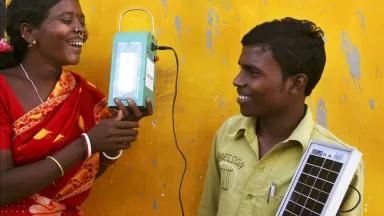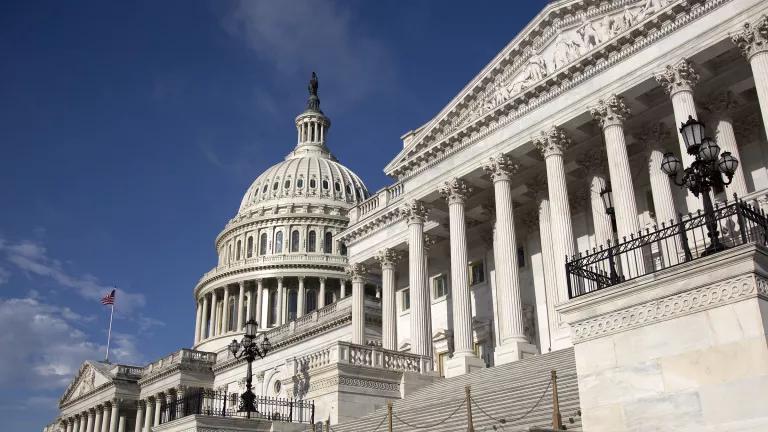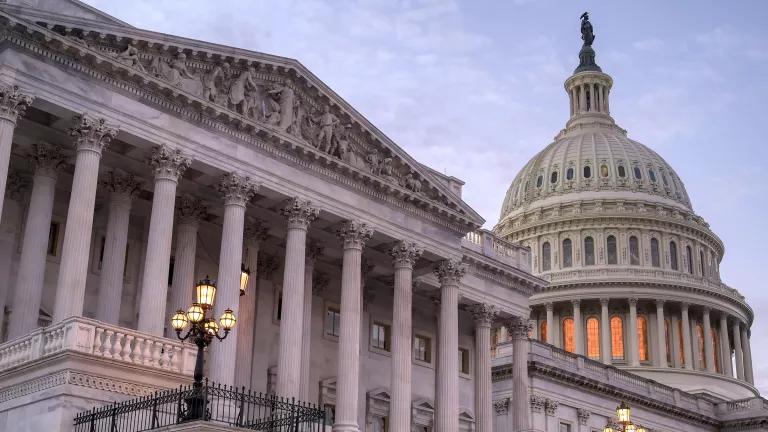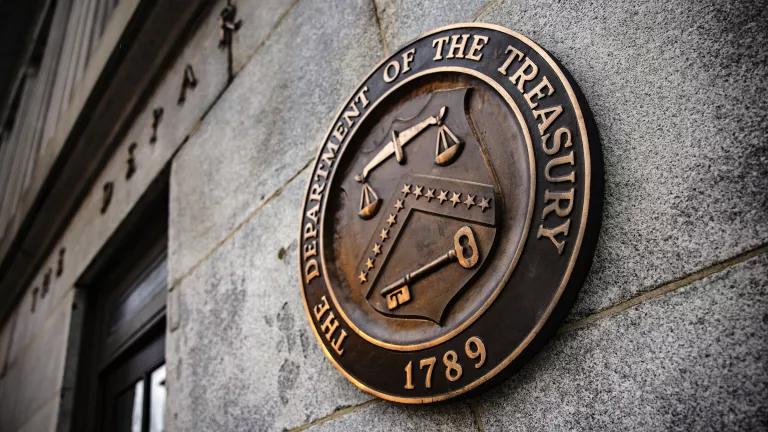A Climate Week to Advance Urgent Change
As the hottest summer on record draws to a close, the next several months could determine whether the world rises to the moment—or blows past irreversible tipping points.
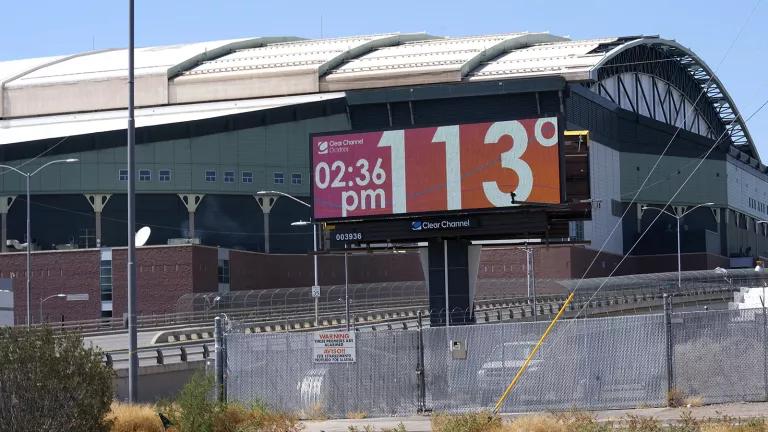
A billboard at Chase Field marks the extreme temperature in Phoenix on July 18, 2023. It was the 19th consecutive day that temperatures hit at least 110 degrees Fahrenheit.
Ross D. Franklin/Associated Press
A summer of cascading climate disasters is giving way to the promise of fall, calling us all to roll up our sleeves with new resolve to confront the existential crisis of our time.
There’s urgent work to do at home and abroad—building on the powerful climate and clean energy incentives enacted last year in the United States and pressing for greater global ambition, accountability, and equity at pivotal world climate talks later this fall in Dubai.
As the hottest summer on record winds to a close, the window to hold global warming to 1.5 degrees Celsius (2.7 degrees Fahrenheit) is rapidly closing. We need assertive action—now—to confront a widening climate crisis that is intersecting with, and exacerbating, a global biodiversity crisis, a global food crisis, and a crisis of global injustice.
The next several months could well determine whether the world rises to the moment or blows past irreversible tipping points.
Warning signs have come and gone. A new wave of genuine disaster is bearing down like a runaway train.
- This week, we’ll finish the hottest summer since global recordkeeping began 174 years ago. Dangerous heat waves swept parts of China, Europe, India, and two-thirds of the United States, on a scale that scientists say would have been “virtually impossible” absent climate change.
- Across Canada, wildfires burned enough land to cover the state of Florida, sending smoke that blotted out the sun as far away as the White House. Fire incinerated the idyllic Hawaiian town of Lahaina so fast that at least 115 people didn’t have time to escape with their lives.
- Half the world’s oceans are so warm that coral and other marine life are threatened by heat that amps up storms like the post-tropical cyclone Lee, which hammered parts of New England and Nova Scotia, Canada, this month.
- Drained by weather and climate disasters that wrought $178 billion in damages across the United States in the last year alone, insurance companies are stepping back, making it harder, if not impossible, for homeowners to buy protection against wildfire, storm, and flood damage in states like California, Florida, Louisiana, and elsewhere.
Climate disasters are, in fact, hurtling at us so fast and furious that they threaten to overwhelm our ability to recover or adapt, as a nation and as a global community.
The response is not to fall into despair and throw up our hands in defeat. It’s to roll up our sleeves and work for change, and never more so than now. For even as climate hazard and harm continue to widen and mount, momentum is building for change.
In the year since the Biden administration and congressional Democrats enacted the Inflation Reduction Act, the clean energy and climate incentives in the law have driven a heartland manufacturing renaissance with clean energy at its core.
Over just the past 12 months, companies have announced more than $86 billion in new investment to build or expand factories that make solar panels, wind turbines, electric vehicles, and advanced batteries.
This investment is creating more than 75,000 jobs in Georgia, Michigan, Ohio, South Carolina,and 35 other states, both red and blue, adding to a clean energy workforce some 3.3 million strong.
What’s needed now is for Congress to defend the benefits of the Inflation Reduction Act—including lower costs for energy, electric cars and trucks, home efficiency improvements, rooftop solar, heat pumps and more—from partisan attacks, and to make sure these benefits continue to make life better for families across the country.
The Biden administration, meanwhile, is complementing these incentives with new rules proposed last spring to help cut carbon pollution from cars, trucks, and power plants that burn coal and gas. We’re counting on the administration to strengthen and finalize these standards by early next year.
Taken together, and done right, these new standards, along with the new federal clean energy and climate incentives in the Inflation Reduction Act, can position the country to cut carbon pollution and other greenhouse gas emissions 45 percent, below 2005 levels, by 2030.
That’s within striking distance of President Biden’s pledge to cut emissions 50 to 52 percent by then. We’ve got to hit that target—and even exceed it.
The United States’ progress is mirrored elsewhere through, for example, the European Green Deal Industrial Plan and major clean energy investments in Canada
What’s needed in the coming weeks is for China, India, European Union members, the United States, and other major emitting countries to raise their ambition and put concrete plans on the table to speed the shift away from fossil fuels and toward cleaner, more sustainable ways to power our collective future.
The COP28 international climate talks, taking place from November 30 to December 12 in Dubai, will focus on what’s called the global stocktake, a scorecard of where efforts to cut greenhouse gas emissions stand.
Under the landmark 2015 Paris climate agreement, countries report regularly on the progress they’re making, and project to make, based on policies that each has in place. As things stand now, the world is on track to blow past the limit of 1.5 degrees Celsius of warming that 195 countries agreed to support in Paris.
“Much more ambition in action and support is needed,” to speed the phaseout of the fossil fuels that are driving the climate crisis, the United Nations makes clear in a report this month.
The leader of every nation needs to show up in Dubai committed to a concrete plan, backed by specific policies, to cut greenhouse gas emissions faster, and more deeply, than they’ve pledged to date.
This is especially true for wealthy nations, large emitters, and those that continue to lock in future dependence on fossil fuels. Just 20 countries, led overwhelmingly by the United States, are responsible for nearly 90 percent of the new oil and gas extraction—and the carbon pollution it will bring—that is planned between now and 2050, concludes a report released this month.
Greater ambition means nothing, of course, without greater accountability and the political will to implement it. A transition of this scope and scale requires a unifying vision of a more just and equitable future, supported by clean energy, thriving biodiversity, and sustainable livelihoods with security and dignity.
Measures to monitor and report on emissions reduction efforts must be strengthened and given real teeth so that nations can share what’s working and what’s not, learn from each other’s experiences, and hold each other to account for making good on the actions they pledge.
In the coming weeks, for example, the United States and other nations must come together around a set of monitoring, reporting, and policy commitments to make sure countries keep the promise they made at COP26 in Glasgow to end and reverse deforestation and degradation by 2030.
As rich habitats for biodiversity, the world’s forests absorb a third of global fossil fuel emissions each year while also storing vast amounts of carbon in their trees and soils. We must protect these forests to avert climate catastrophe.
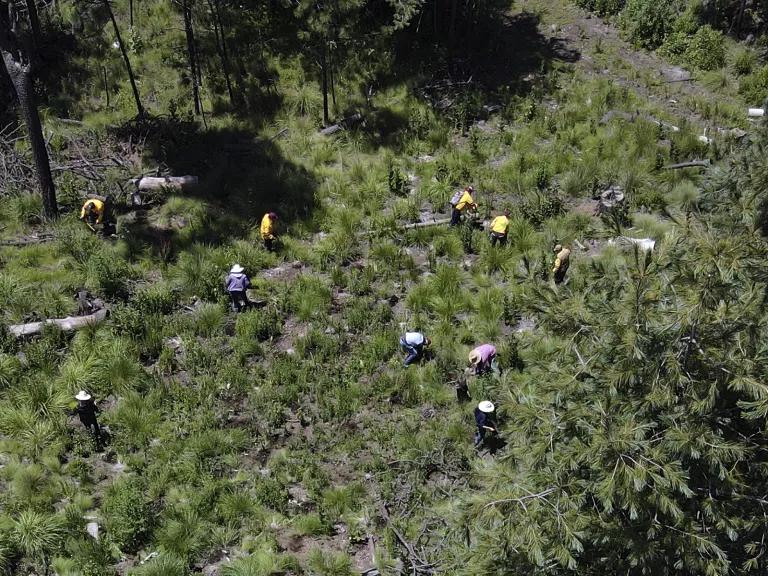
Locals plant pine saplings in San Miguel Topilejo, Mexico City on August 13, 2023. Because this forested area is crossed by highways, illegal logging by gangs is rampant.
Marco Ugarte/Associated Press
The world’s forests, though, are being destroyed at a staggering rate, chiefly by industrial logging and commodity-driven deforestation.
Last year alone, the world lost enough tree cover to blanket the state of Minnesota.
Much of this is tropical rainforests, the lungs of the world. Over the past two decades, though, 37 percent of all industry-caused tree cover loss was in Canada, Russia, the United States, and other parts of the Global North, with substantial climate impacts.
Leaders from those three countries and some 140 others signed the Declaration on Forests and Land Use in Glasgow. What’s needed now are accountability measures to hold each to their word.
Finally, COP28 must address, head on, the question of global environmental injustice.
It is one of the most ignominious injustices of our time that, across the developing world, more than a billion people living on the jagged frontlines of climate hazard and harm are paying a price they can’t afford for a crisis they didn’t cause.
This injustice must be addressed.
In 2009, at COP15 in Copenhagen, the United States and other wealthy nations pledged to raise $100 billion a year, by 2020, to help developing countries invest in clean energy and efficiency and to cope with the consequences of climate change.
As of 2020, the last year for which complete figures are available, countries provided $83 billion, falling 17 percent short of the pledged amount. Rich countries claim to have finally closed the gap this year. We’ll see.
What’s clear is that more is needed from wealthy countries, starting with the United States.
Based on its greenhouse gas emissions—the second largest in the world, behind China—its economic strength, and its population, the United States’ share of the $100 billion should be at least 40 percent.
Instead, the U.S. contribution has been less than $10 billion a year. President Biden has pledged to raise that to $11.4 billion annually by next year, the absolute minimum the United States should provide.
Beyond this needed investment in global equity and a just transition from dirty fuels to clean energy, leaders agreed last fall, at COP27 in Cairo, to establish a special fund to help vulnerable nations confront specific loss and damage resulting from climate change.
In the coming weeks, leaders need to work together and bring to Dubai a concrete plan to operate this fund and, most important, make tangible commitments to start putting together public and multilateral financing to put resources on the ground where they’re needed most.
This is funding needed to help protect developing countries from rising seas, develop drought-resistant crops, put in place extreme heat warning systems, and otherwise help vulnerable countries cope with the rising costs and mounting dangers of climate change.
It’s not charity. It’s what wealthy, high-emitting countries owe frontline countries for the harm that’s been done. It’s an investment in a climate-resilient world.
The United States, European Union, China, and Russia together account for 63 percent of the climate-wrecking carbon pollution that’s accumulated in the earth’s atmosphere over time from the burning of coal, oil, and gas.
Ten countries that are most acutely vulnerable to climate hardship and hazard—Haiti, Mozambique, Pakistan, and seven others—have together contributed 1 percent.
Put another way, the richest 1 percent of the world’s population is responsible for more than twice as much carbon pollution as the poorest half of the world’s people combined, as concluded in a recent study by the justice and climate advocate group Oxfam International.
This is climate injustice on a global scale. Wealthy nations need to step up and confront it this fall in Dubai.
Ambition. Accountability. Equity.
These are the legs that we—as climate advocates, as countries, large and small, and as a global community of nations—must stand on in the weeks leading up to COP28. This summer has given us a glimpse of what lies ahead if we don’t act. We must all be guided by the far greater vision of what can be achieved when we do.
We need climate action to be a top priority in Washington!
Tell President Biden and Congress to slash climate pollution and reduce our dependence on fossil fuels.
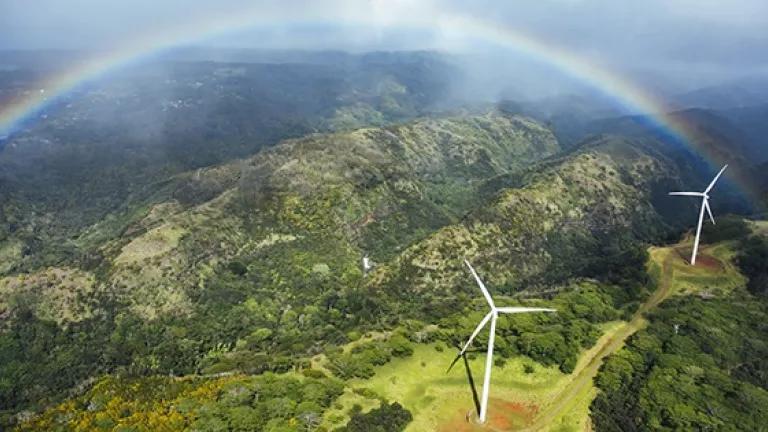
Urge President Biden and Congress to make equitable climate action a top priority
2023 was the hottest year on record, underscoring the urgency of shifting to clean energy and curbing the carbon pollution that is driving the climate crisis. President Biden and Congress have the tools to get the job done.


